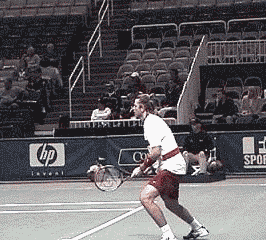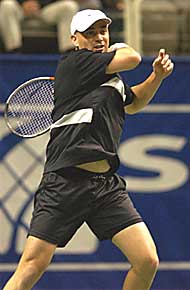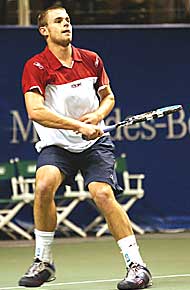TennisOne Peak Performance
![]()
Developing Constructive Mental Tennis
Understanding the KEYS to Learning and Playing YOUR Best Tennis
By David W. Smith
Excerpted from his book, TENNIS MASTERY (Now available!)
Photos by Bill Putnam
Most books, videos and on-court tennis lessons deal primarily with what we call “Stroke Production”…that is, how best to hit a tennis ball. And well they should! For if we can't consistently make the ball go over the net with intention, we will be only guessing (and perhaps praying!) where our next shot might land.
Interestingly, as we do indeed perfect our abilities to “stroke” the ball into our opponent's court, a new set of variables enters the picture. These variables include what I call “Mental Tennis.” Once expectations (in our abilities) are established, our mind begins to formulate thought patterns that contribute to or distract from our very ability to execute the shots we have learned!
Mental Tennis can take on many definitions in how it relates to player performance on a tennis court.
Many people associate “Mental Toughness” as being the all-encompassing phrase used to define an accomplished tennis player. This broad term has, indeed, been written about in tennis texts for decades. However, Mental Toughness is just a part of the overall “Mental” picture. Mental Tennis includes more. It includes both on and off-court stroke preparation and strategic understanding; it includes mental toughness training, and it includes something that can't be gained in practice: Competitive Experience. Many players fail to recognize these associations. Thus, many of these individuals fail to study and, ultimately, are unaware of how they can and should train for the Mental Tennis aspects of tennis.
 Mardy Fish has made huge strides over the last year partly due to his improved toughness on the court. |
Mental Toughness
Mental Toughness is derived from the overall preparedness that a player understands as being a necessary part of Mental Tennis. In my opinion, Mental Toughness is a resulting factor, one that a player gains through his or her determination in reaching Tennis Mastery.
There are many definitions for mental toughness as it applies to tennis. Some might say it is the resistance to choking. Others might define it as solid concentration or not easily distracted. These would certainly be in the right ballpark.
However, mental toughness is much more than what those definitions might infer. Through years of coaching and observing thousands of players, young and old, I prefer the following definition:
Mental Toughness is a conditioned and positive response to adversity.
If you look at any competitive match, or set that has something riding on it, these matches offer adversity. Whether it is the match itself or the points within the match, potential conflict can ride on every stroke.
Certainly, there are variables that add or detract from the severity of pressure each match or point contains. Match variables could include whether or not an opponent is recognized as a threat or what the match means for the player or for their team if it is a team match. Or, if it is a tournament, variables include the round in which the match is being played, seeded players, next round opponents, and others.
Pressure point variables include what the game or set score is, points that are played in tiebreakers, points played after “momentum shift” points, (points that can alter the complexion of a match), and, certainly game points and match points carry significant pressure. Because of these variables, Mental Toughness can be used to describe how well a player reacts and responds to such variables.
A Conditioned, Positive Response: This means that it can be learned. I have not seen a single player who was not capable of developing Mental Toughness.
I have witnessed players who were not successful at developing Mental Toughness; some of these players were members of my own teams who had developed phenomenal strokes, incredible serves, lightning fast feet, and terrific agility. We have all seen this type of player…the one who can drill with the best players, hit 100 mile-per-hour serves, and hit targets with groundstrokes off the ball machine…
But they can't win a match.
What is this player missing that other players, those with perhaps even less natural ability, have?
You know the answer: Mental Toughness.
As you become better prepared for your matches, you will find it difficult to accept defeat. My favorite coaching phrase is: “The harder you work, the harder it is to fail.” Certainly, any hard work you perform will make the goals of that hard work that much more valuable to you. However, don't confuse the simple concept of “hard work” as being the gist of the lesson. Otherwise, you might find yourself discovering another concept: futility! Working hard on faulty form will only make changing that form more difficult when you realize that the faulty form is limiting you. Tennis mechanics at every level must be clearly understood so that you will be working “hard” on the very form that will give you the best results.
|
Click photo to hear Dave Smith talk about tanking, anger, and choking. |
Once you have put in the hard work, the next step is implementation of proper form and strategy in competition. How often do we see tennis players working on specific shots or strokes in practice only to completely abandon those things in competition! It is no wonder that one of the first books on the mind in competition was a book dealing with the mental side of tennis!
In 1972, Timothy Gallwey's The Inner Game of Tennis was a revolutionary revelation in dealing with sports psychology. So popular was Gallwey's book and approach that over 700,000 books were sold around the world! I highly recommend that tennis players today pick up a copy of his book if they are not already in possession of it.
In Gallwey's book, he describes “Self 1” and “Self 2”. Self 1 is our controlling voice, the critic. Self 2 is the self who performs. Gallwey says, “The more you trust self 2, the better you will play.” When we let Self 1 dominate our actions (and our minds) in competition, we open ourselves to all the variables that tend to destroy our mental toughness. Those variables include:
- Tanking: This is when a player simply “gives up”. This is the “excuse maker”, the whiner, and the complainer. Players resort to tanking to absolve themselves of the pain that accompanies losing. Players who tank matches don't hurt as much when they lose because tanking protects their ego. The tanker has a built-in excuse: “I didn't win because I didn't try.” We can face our friends and peers with this false reasoning. The phrase, “I could have won if I really wanted to” is a common statement made by a tanker. While tanking protects the ego, it prevents a player from winning and, in a real sense, it can prevent a player from becoming a champion.
- Anger: This is when a player allows his or her emotions to control them. Showing anger, like tanking, is an emotional response designed to protect the ego. Anger provides a player with the excuse, “I didn't win because I was so mad.” Anger also projects the false image of a player who is trying. Instead of focusing their energy on the match, the angry player focuses on how he is observed and perceived by others.
- Choking: This is the emotion that all competitors hate. It is a physiological response to fear and doubt. When a player doubts himself, the results are painful to experience and to watch! Everything seems to move too fast, players can't think straight, and there is a feeling of anxiety. When fear consumes us, the simple seems hard; the logical becomes illogical; the present seems like the past. In one sense, however, choking is a far better response than anger and tanking because even while we are choking, we are trying. Choking is more of an innate response to competition than a conscious choice. Although anger and tanking are sometimes chosen avenues for many, choking is almost never an elected response.
When players gain confidence, their ability to play in “the moment” increases. Highly skilled players learn through a variety of experiences to play tennis without focusing on these detrimental tendencies. Those experiences usually include both a practice foundation based on the principles of the Advanced Foundation (which I have outlined in many articles), and playing experiences that are gained through a variety of competitive environments.
A player simply can't accelerate through lessons to obtain the aspect of actual playing experience. All players will have varying degrees of success in gaining the necessary mental aspects to playing under pressure. Some players might be ahead of the mental game through having some previous sporting experiences. Others can have a predisposition for becoming mentally tough while others have to work at it for a long period of time. I have found that the mental capacity of players, those who can play tough when the pressure is on, is more an inbred trait than the athleticism necessary to simply learn tennis strokes. More players have overcome limited natural physical conditions faster and easier than players who have to overcome limitations related to the mental game!
There is an excellent axiom that I read in the book “Zen in the Martial Arts ” by Joe Hymas that is related to this issue of playing in the moment:
| “Seize the Moment: You must learn to live in the present, not in the future or the past. Zen teaches that life must be seized at the moment. By living in the present you are in full contact with yourself and your environment, your energy is not dissipated and is always available.” |
Tennis players who play competitive matches with any part of their mind focused on the outcome of any match will not play within their “competitive moment.” Examples of situations that will take players out of their “competitive moment” are:
- Worrying about what the results of the current match may mean
- Still thinking about a great shot hit
- Still thinking about a bad shot hit
- Thinking about your next match while still playing within another match
- Worrying about what will happen if they lose this game/point/set
- Thinking about how great they are playing
- Thinking that they are going to win the match
- Thinking that they should easily win or lose a match before it begins and during it
- Fuming about a bad call made earlier in the match
- Thinking about the lucky shot your opponent hit any time after the fact
|
Click photo to hear Dave Smith talk about playing in the moment. |
The most common example of these listed is when a player serves an ace. I don't know what the statistics are, but it is very common for a player to double fault on the subsequent point following an ace. The reason is simple. The server is conscious of the ace and believes he or she can do it again. The lingering memory of the ace is still strong in the mind of the server. Instead of focusing on what exactly the server needs to do on the next serve, the memory of the ace is still the predominant mental thought. If the first serve is missed, the player often focuses on not wanting to double fault following such a great serve (the ace) on the previous point. Again, the player is not focused on where they want to hit the serve, they are thinking about the potential outcome if they make or miss the serve.
Dealing with the Ego
Notice that the three negative response variables, (tanking, anger, and choking) center on the player's ego. When a player is concerned with his ego, tanking and anger are the first to show their ugly head! I have used a phrase for years as a general statement to developing better mental tennis:
“When we play and practice not to satisfy our ego but to satisfy our goals, we allow the best tennis to emerge.”
Think about this phrase. If we are concerned with our egos, we are concerned with what others think about us, (or in some cases, what we think about ourselves). If, however, we are concerned with our goals, we are then focused on things related to our development as a tennis player. If they lose a match, ego-centered players will look for excuses. Goal-centered players will look for ways to learn from the loss and improve.
The ego can sometimes be correctly “channeled” to help reach goals. When we want to prove something because of our ego, we then almost subconsciously recognize the value of goals.
Players trained in elementary stroke patterns (that are not recognized as skilled or progressive) and recognizing they need to change are often victimized by their own ego. Let me give you a scenario:
 |
 |
Top pros like Agassi and Roddick maintain focus despite the pressue or the score. That is why they win so many close matches. |
|
Julie, who is 35 years old, is a 3.5 player. (10 years at 3.5!) She has finally broken down and received accurate tennis instruction on her serve/volley/backhand. (You can choose!) She has worked in practice on her new stroke and knows what she should do to hit the ball correctly within the parameters of the new technique. However, when she gets in a match, she goes right back to hitting her old, inferior strokes.
Why?
Julie felt that if she tried her new strokes there would be a perception of failure: If she used her old strokes, she believed she could at least compete at the 3.5 level in which she was used to playing. So, Julie let her ego dictate what she did in the competition. Instead of forgoing the ego and making or missing with her new strokes in match play (and improving each shot in the process!), she took the ego-easy way out! Sadly, as she continues repeating this scenario throughout her playing days, she will, of course, continue to play at the 3.5 levels essentially forever.
Conclusion
Every player who wishes to become a “skilled” player as well as one who is “mentally tough” must play and learn the game with “intention.” Intention indicates that a purpose is involved in each realm of playing or learning. Without a clear understanding of the intention—and corresponding goals, a player will usually compete at levels far below their potential. A simple analogy would be this: If I were capable of running, would I want to crawl? I know I can get from point A to point B by crawling…and if I am just starting to run, I might even fall a few times. Crawling would prevent me from falling. Should all I do is crawl? Think about it.
Your comments are welcome. Let us know what you think about Dave Smiths' article by emailing us here at TennisOne.
![]()
 TENNIS MASTERY
TENNIS MASTERY
Finally… a resource that unlocks these mysteries:
• Why do millions of tennis players stagnate at levels far below their potential?
• Why are making changes in one's game so frustratingly difficult?
• What tennis teaching methods are disruptive or detrimental to player progression?
Read David W. Smith's TENNIS MASTERY and learn not just how to avoid playing at mediocre levels, but how the best players in the world Master the sport of tennis!
“With a depth of knowledge and fresh perspective, TENNIS MASTERY is set to become a manual for tennis instructors and a measure for tennis literature.” Richard Wigley, Director, Kayenta Tennis Center , Ivins Utah .
Take in David Smith's 30 plus years in the tennis teaching industry. This 335 page manual will provide every level of player as well as support for all tennis teaching
Order TENNIS MASTERY at tenniswarehouse.com , or go to tennismastery.net for exciting excerpts from the book and a host of tennis information!
And check out David Smith's other articles found here at TennisONE.com!
![]()
 Your comments are welcome. Let us know what you think about this article by emailing us here at TennisONE.
Your comments are welcome. Let us know what you think about this article by emailing us here at TennisONE.
David W. Smith is the Director of Tennis for the St. George Tennis Academy in St. George Utah. He has been a featured writer in USPTA's magazine ADDvantage in addition to having over 50 published articles in various publications.
David has taught over 3000 players including many top national and world ranked players. He can be reached at acrpres1@email.msn.com.
